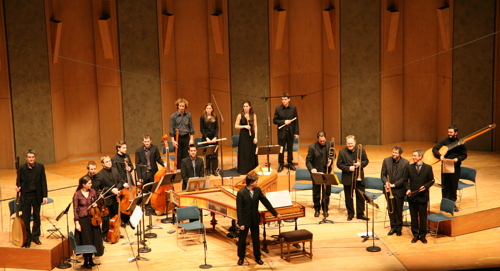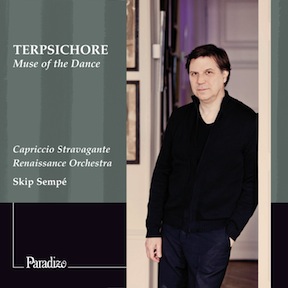
This is one of those amazing parties on a disc. The party planner is harmpsichord master Skip Sempé, who has divided up instrumental music by Michael Praetorius (1570?-1621) and William Brade (1560-1630) into four extended suites.
- Classical Music 101: What Does A Conductor Do? - June 17, 2019
- Classical Music 101 | What Does Period Instrument Mean? - May 6, 2019
- CLASSICAL MUSIC 101 | What Does It Mean To Be In Tune? - April 23, 2019
 The album, Terpsichore: Muse of the Dance, is released on Sempé’s own Paradizo label.
The album, Terpsichore: Muse of the Dance, is released on Sempé’s own Paradizo label.
Sempé, like fellow period-performance force William Christie, is an American who escaped to France in order to find peace, fulfillment and fame in pre-Modern music. Christie created Les Arts florissants; Sempé’s ensemble, Capriccio Stravagante, celebrates its 25th anniversary this season.
Both men are tireless seekers and performers, and the results of their work just keep getting better and better.
Sempé’s latest album is all about the colourful glories of the late Renaissance and early Baroque, the cusp of the 17th century.
Many of us associate Michael Praetorius with upright German Lutheran church music. But he also compiled hundreds of Renaissance dances in a collection he named Terpsichore in 1612. William Brade was an Englishman who spent his working life in Brandenburg and Copenhagen. What little of his music survives is also about courtly dances.
Sempé has organized their best pieces into four Ballo suites, themed by affect. So we get unbridled joy in one, tragedy in another.
The scores are consort oriented, meaning that instead of having musical lines divided up by instrument type, as we have in a modern orchestra, the musical lines are shared across instruments. It makes for a different feel and sound. The effect is magnified and brightened by having 20-plus people playing at the same time.
Among the many background revelations for someone not totally immersed in Early Music is the presence of the “tiorbino” harpsichord. Music scholars have long known that there was an early type of harpsichord that was strung with both metal and gut strings, with the player being able to chose between the two. Now, thanks to an old instrument found in a Milan museum, we have a working tiorbino harpsichord, played by Montrealer Olivier Fortin, a frequent guest of Tafelmusik in Toronto.
This is one of those albums that even someone who doesn’t listen to this sort of music should sample. The fun and beauty are that infectious.
For some reason, the Paradiso website does not have any information on this album, number PA0011. You can order the album from Toronto independent, Atelier Grigorian here.
Here is a promotional clip for the disc:
John Terauds
- Classical Music 101: What Does A Conductor Do? - June 17, 2019
- Classical Music 101 | What Does Period Instrument Mean? - May 6, 2019
- CLASSICAL MUSIC 101 | What Does It Mean To Be In Tune? - April 23, 2019



